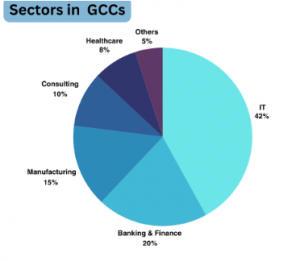Did you know India’s GCC revolution was kicked off in a bullock cart? Surprised? Texas Instruments, the first multinational to set up a software design centre in Bengaluru, arrived in true bullock-cart style. Their satellite dish — crucial for 24/7 communication with the US — showed up on a traditional bullock cart, not a high-tech truck. This seemingly low-tech delivery marked the high-tech beginning of India’s IT revolution — or rather, the GCC revolution.
Fast forward to today, India boasts over 1,580 Global Capability Centers (GCCs), making it a significant driver of employment and innovation in the country. As these centers continue to scale, PeopleLogic, one of the top RPO providers for GCCs in India, plays a key role in helping them attract, build, and retain world-class tech and business talent.
This week, we dive into the booming world of Global Capability Centers (GCCs) in India — exploring their rise to prominence, the impact they’re having on the IT industry, and how they’re shaping the future job market. As always, PeopleLogic is committed to providing our readers with the latest trends, technologies, and news in the industry so that they can stay informed and ahead of the curve.
GCCs – The Journey!
Texas Instruments opening its software design centre was just the beginning. Soon, Microsoft, Adobe, Google, Oracle, IBM and many other major companies followed suit. Back in the day, GCCs or GICs (Global In-house Centers) were essentially offshore units set up by big multinational companies in other countries, like India, to handle specific tech and business support tasks, mainly back office operations finance, accounting, IT support and data entry. Thus the initial wave of GCCs in India focused on cost arbitrage. Companies set them up to leverage the large talent pool and lower operational costs compared to their headquarters.
Today, GCCs in India have matured beyond just cost-effectiveness. They are handling more complex tasks like analytics, research & development, and even core business operations. They’re now seen as strategic partners driving innovation and growth for global businesses.
India’s Global Capability Center (GCC) sector is booming, with over 1.6 million professionals currently employed. This trend is expected to continue, as per a study conducted by EY, with projections indicating over 2,400 GCCs operating in India by 2030, creating job opportunities for more than 4.5 million people. The market size will grow to US$110 Billion in 2030 from the current US$45Billion.

- Image Courtesy: IBEF

- Image Courtesy: IBEF
GCC Landscape
The IT sector dominates India’s GCC landscape, accounting for roughly 42% of all centres. Financial services and banking follow closely at 20%, with manufacturing occupying a 15% share.

Types of GCCs
Majorly there are four types of GCC centers
Shared Services Centres: Finance, HR, IT and procurement are all in one place
R&D centres: Innovation hub for new products, technologies and processes
Knowledge centres: To help organisations remotely share information
Innovation Centres: Companies can develop new ideas, conduct research and build prototypes
Customer Service Centres: For managing customer inquiries, complaints and feedback
GCC Hotspots
Bengaluru has the maximum number of GCCs followed by Hyderabad, Chennai, Mumbai and Pune. In fact Pune with its manufacturing ecosystem has attracted numerous GCCs to start shop.

Factors Fueling GCC Growth In India
India’s emergence as a preferred destination for GCCs can be attributed to several key factors apart from cost arbitrage
Talent Pool: India boasts of one of the enviable skills workforce. India has around 2.5 Million STEM graduate supply and its tech demand supply gap is the lowest at 25% as compared to US, UK, Canada and Australia. Additionally, India graduates a staggering 1.5 million engineers annually, positioning itself as a prime talent pool for the GCCs.
Government Support: Many states in India are offering subsidies, and other incentives to GCCs to set up offices. A recent news article about Tamil Nadu wooing GCCs by offering payroll subsidies is one such example. Karnataka government’s Spoke Shore project which is speeding up the creation of GCCs across the state with a focus on Tier 2 and 3 cities is another example. Several Indian states, including Uttar Pradesh, Telangana, and Maharashtra, have implemented policies that incentivize investment from the GCC in key sectors like auto & electric vehicles, electronics, pharmaceuticals, and life sciences.
Digital infrastructure: India’s digital infrastructure has improved significantly in recent years, with high-speed internet connectivity becoming increasingly widespread. This robust infrastructure ensures seamless connectivity and data transfer, crucial for efficient GCC operations.
GCCs – The Current Trends
on Tier 2 /3 cities: Even though 70% of all GCCs are based in India’s own silicon valley, Bangalore, GCCs are now expanding into Tier 2/3 cities like Vadodara, Ahmedabad, Nashik and Mysuru. The first half of 2023 saw at least 5 GCCs expanding into the Tier 2 cities. This expansion into the Tier 2 cities is happening sector wise. For example, Ahmedabad has become a favourite destination for BFSI GCCs.
Shift Towards Innovation: Shedding their back-office roots, Global Capability Centres (GCCs) are transforming into strategic powerhouses, driving innovation and generating significant profits

- Image Courtesy: IBEF
Partnerships and Collaboration with Startups: India’s dynamic startup ecosystem and strong R&D community are being leveraged by GCCs. As per EY, GCCs have established more than 15 incubators, over 40 accelerators, and multiple partner programmes to drive collaboration with Indian start-ups. Healthcare and pharma GCCs have seen an increased partnership with start-ups and academia to access newer technology. The GCCs are exploring various forms of collaboration such as innovation labs, hackathons and start-up incubators.
Increase in digital transformation: The post covid world saw more and more organisations opting for digital transformation. GCCs will utilise the robust talent pool in India to enable digital transformation at a global scale.
GCCs – Future Road Map
The future of GCCs in India looks bright. As technology continues to evolve and global competition intensifies, MNCs will increasingly rely on their Indian capabilities for innovation and strategic growth. GCCs have already become major employment generators esp in the IT industry amidst the decline in hiring in the IT services sector. Also, they will expand into other areas like legal, marketing and procurement. Furthermore, GCCs will increasingly leverage automation technologies like artificial intelligence and robotic process automation to further optimise operations. Indian professionals working in GCCs are anticipated to take on more leadership roles within MNCs at a global level.
Generative AI evolves, GCCs will experience phenomenal growth. Generative AI will transform the way GCCs will operate and optimise processes.
PeopleLogic Opinion
India’s GCC sector has emerged as a powerhouse, driven by a skilled talent pool, cost-effectiveness, and government support. By embracing innovation, fostering leadership roles, and continuously developing its talent pool, India is well-positioned to capitalise on the immense growth potential of GCCs. These strategic hubs will not only propel India’s economic growth but also position the nation as a leading player in the globalised world of tomorrow.
With a deep understanding of the GCC landscape and its ever-evolving talent needs, PeopleLogic is strategically positioned to provide exceptional talent solutions. Our ability to assess not only technical skills but also cultural fit and future potential ensures that GCCs in India have access to the most qualified professionals to fuel their growth and innovation journey






